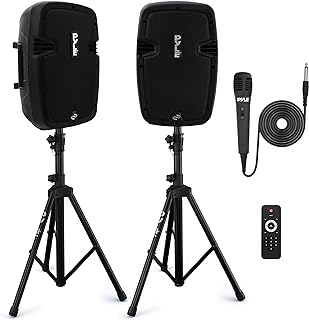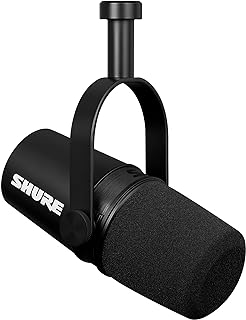5 important factors worth considering when looking for the best dynamic microphone
When you start recording audio, choosing the right dynamic microphone is crucial for achieving the best results. With so many options to choose from, it’s important to consider important factors like quality, durability, versatility, and compatibility. These aspects are key in producing high-quality audio. By keeping these things in mind, you can unlock your creativity and skills in sound production.
See our guide to the best dynamic microphone.
Sound quality
When it comes to buying a dynamic microphone, one of the most important things to consider is the quality of the sound it produces. A good dynamic microphone can capture sound accurately and clearly, which is crucial in professional settings where even the smallest details matter. Whether it’s for podcasts or live performances, the sound quality of a dynamic microphone can make a big difference in how the audience and performer experience the audio.
In the world of dynamic microphones, sound quality is key. A top-notch dynamic microphone can reproduce voices and instruments with amazing accuracy, capturing the true essence of the sound. The subtle details that a dynamic microphone can pick up help create a richer and more engaging listening experience, allowing the audience to really connect with the content being shared. With so much audio out there, investing in a high-quality dynamic microphone that prioritizes sound quality can help you stand out and ensure your message is delivered clearly and effectively.
Durability
When it comes to buying a dynamic microphone, it’s important to think about how long it will last. While sound quality and performance are important, durability is what sets a reliable microphone apart from a fragile one. Microphones that can handle frequent use and travel give you peace of mind and are a good long-term investment. A strong microphone not only protects your money, but also works well in different situations, making it a reliable tool for recording audio. Choosing a durable microphone is like investing wisely in your work, something that will last a long time.
A durable microphone can make your recording experience better by eliminating worries about it breaking. Whether you’re a professional artist on stage or a content creator making podcasts at home, a sturdy microphone means you don’t have to worry about it wearing out, so you can focus on being creative. A microphone’s resilience shows how well it’s made, proving its quality and craftsmanship, and making it a dependable tool for capturing good audio. In a world where technology often breaks, choosing a durable microphone lets you focus on improving your skills without worrying about equipment problems.
Directionality
Choosing a dynamic microphone is important for getting the best performance. Different types of microphones like cardioid, omnidirectional, and bi-directional have different ways of picking up sound. A cardioid microphone is good for recording in noisy places because it mainly picks up sound from the front and reduces background noise. On the other hand, an omnidirectional microphone picks up sound from all directions, which is great for capturing ambient noise or recordings with a group of people. Knowing the directionality of a microphone is key to picking the right one for your needs and improving the quality of your audio recordings.
The directionality of a microphone is crucial for clear and precise sound. By considering directionality before buying a dynamic microphone, you can make sure you get the best microphone for your recording needs. Whether you’re a podcaster, musician, or content creator, choosing a microphone with the right directionality can make a big difference in the quality of your recordings. Basically, directionality helps users fine-tune their sound capture and achieve professional results in the world of audio technology.
Frequency response
Understanding frequency response is essential when considering dynamic microphones as it directly impacts the quality of audio capture and performance. Frequency response refers to a microphone’s ability to accurately capture different sound frequencies, making it crucial for tasks like vocal recording and podcast production.
A microphone with a flat frequency response will faithfully reproduce the original sound, ensuring clarity and fidelity in recordings. Conversely, a microphone with an uneven frequency response may highlight certain frequencies while reducing others, resulting in a distorted or unnatural sound profile. This can significantly affect the coloration and tonal characteristics of the audio, either enhancing or detracting from the intended sound.
When purchasing a dynamic microphone, carefully examining the frequency response chart can provide valuable insights into how the microphone will handle different frequencies and align with specific recording needs. Understanding how a microphone’s frequency response impacts its performance across various applications can help individuals make informed decisions to enhance the quality and accuracy of their audio projects.
Ultimately, choosing a dynamic microphone with a balanced and accurate frequency response not only ensures excellent sound quality but also improves the overall listening experience by capturing the nuances and authenticity of every performance.
Price
When buying a dynamic microphone, it’s important to find the right balance between cost and quality. While going for the cheapest option might be tempting, it could mean giving up on durability and sound performance. Spending a bit more on a quality dynamic microphone can really improve the sound and longevity of your equipment. A good microphone can enhance your audio recordings, no matter if you’re a musician, podcaster, or content creator.
Think of the price of a dynamic microphone as an investment, not just a one-time cost. High-quality microphones are designed to last, giving you long-lasting value for your money. A more expensive dynamic microphone usually gives better sound quality, noise reduction, and overall performance, giving you professional-level audio. Remember, with dynamic microphones, choosing quality over price will give you a better recording experience and higher quality sound.
Conclusion
In a world where good sound is important, dynamic microphones are great for live shows and recording studios. They are strong, affordable, and can be used in many different ways. Both experienced professionals and new artists like using them. Dynamic microphones can pick up deep, warm sounds and handle loud noises well. Even as new technology comes out, dynamic microphones are still loved for their classic style and dependability. They have a long history of being reliable in the sound world. Want more info on 3m mask for virus protection made in usa, check the best 3m mask for virus protection made in usa.


